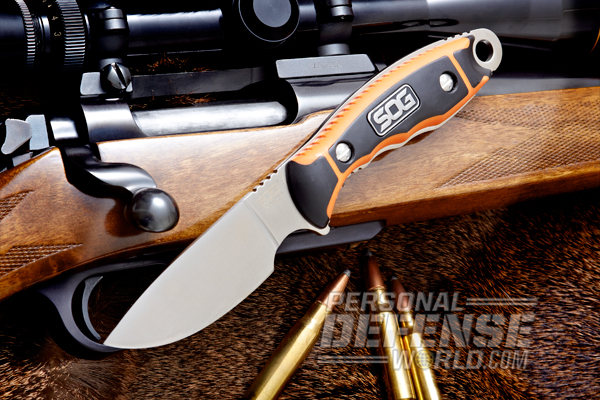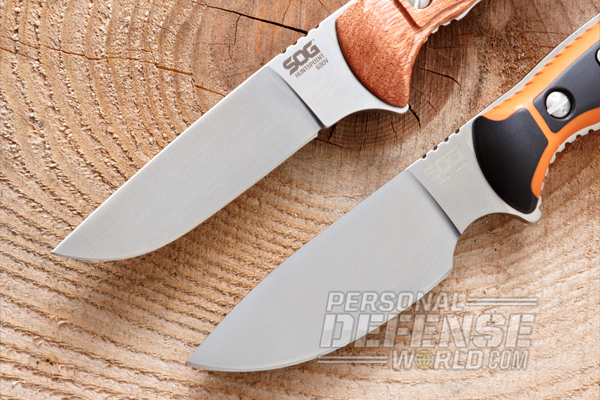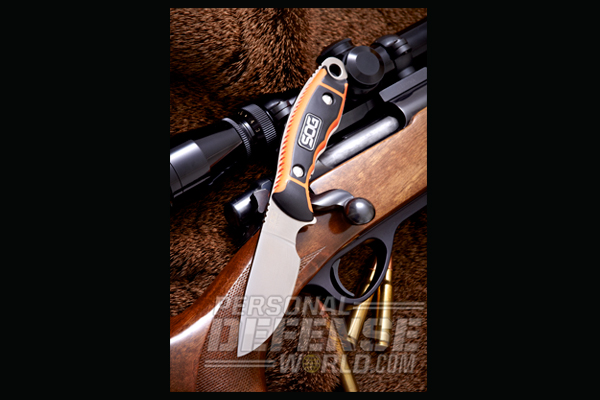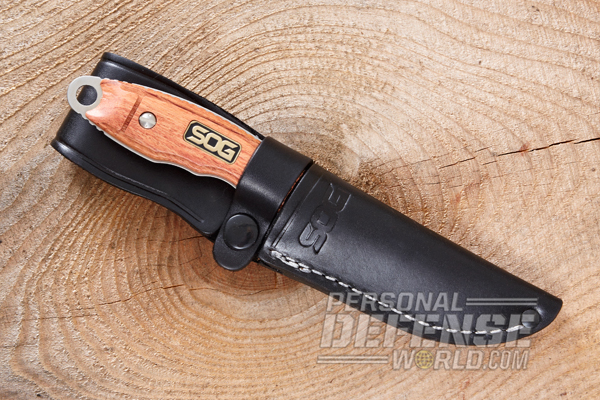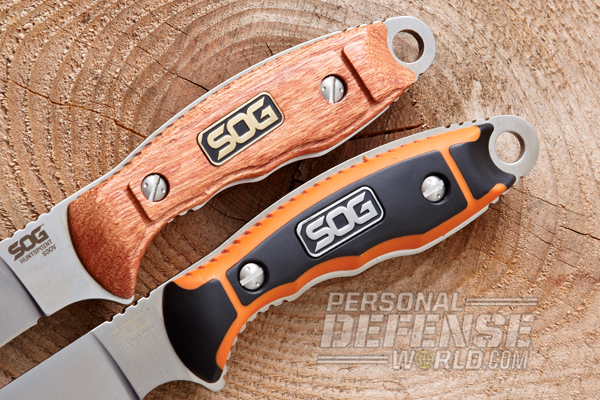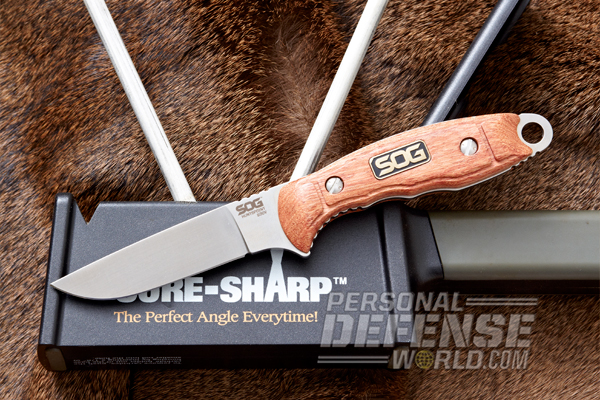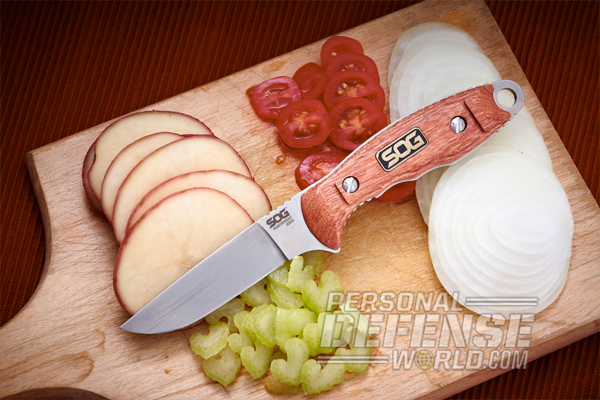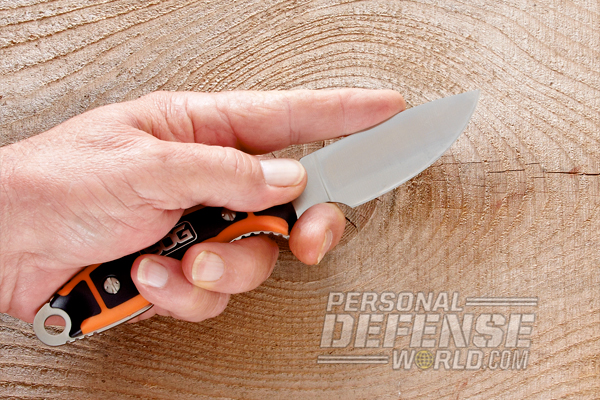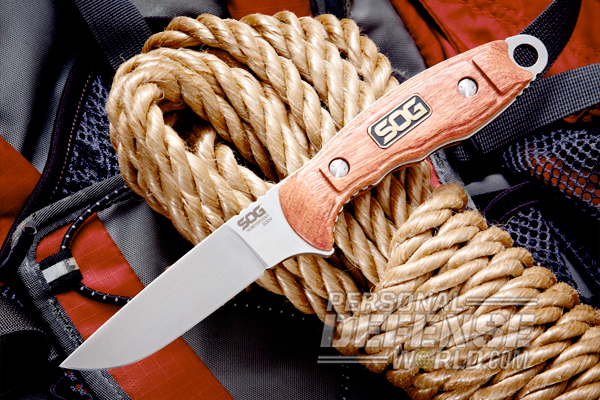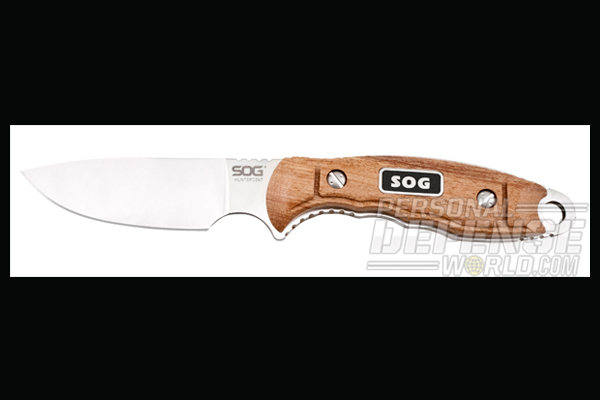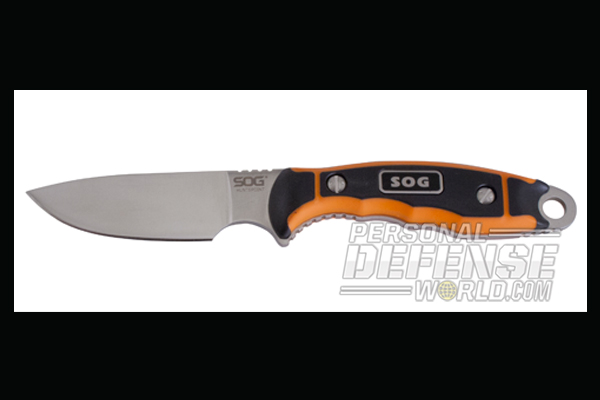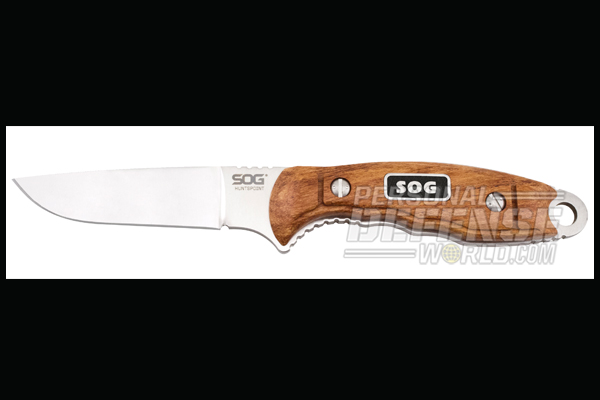SOG Knives has entered the hunting knives world with their new HuntsPoint series!
Once a company is associated with a certain product, you have to wonder if that relationship will “type cast” them, as they say in show business. SOG Specialty Knives & Tools has long been known for its combat, tactical and multi-tools, but in a recent move the company has expanded into hunting knives designed specifically for hunters. I was lucky enough to be given the chance to try out the full HuntsPoint line of SOG game processing blades during our own North Carolina deer season. The new series officially lists six different knives, but a better description would be that there are three variations of two different models. Since the handle shape is identical on both models, the only difference can be found in their blade patterns. One model is referred to as a skinning knife, and the second as a boning knife. Each of the two models is available in S30V stainless steel with rosewood handles scales.
Both models are also available in AUS-8 stainless steel with rosewood, or SOG’s “co-molded” synthetic handle scales. The prices on both blade patterns are the same and the only price variation is between the blade steel and handle materials. The price on the S30V and Rosewood knives are $140, and that drops to $90 for the AUS-8 and rosewood combination. The AUS-8 knives with the synthetic handles have a price of $80. The general specifications on all of the knives are the same. They have a blade length of 3.6 inches and an overall length of 8.2 inches. The knives all have a full tang, which is 0.13 inches thick. Both models have flat-ground, drop-point blades, but the drop to the blade is slightly less on the boning model. The skinner also has a greater width at 1.125 inches as compared to 0.875 inches for the boning knife. The pattern on the boning knife has very little upsweep until the last inch of the blade. The extra 0.25 inches of width for the skinner, and a more gradual upsweep to the blade, creates a little more “belly” for this model. As mentioned, the only other difference between the six combinations of knives is the materials used for the handles and in the blade design.
Advertisement — Continue Reading Below
CLICK HERE To Scroll Down To See the Video!
To some, S30V is considered a premium steel, but AUS-8 also offers outstanding service. Both types of steel are known for taking a keen edge, but S30V may maintain this edge longer. The drawback is, S30V is also harder to initially sharpen than the AUS-8. Given the size of these knives, and their intended use, I doubt the average buyer will notice a great deal of difference between the two steels. The same can also be said about the two types of handle material.
The rosewood will have greater eye appeal to some, but the synthetic scales may appeal to others. In handling both types, the wood actually had a warmer feel and the synthetic felt slightly softer. The durability of both materials, however, should be outstanding. The most notable feature of the handle is that the scales do not extend to the edge of the tang. This results in a slight lip around the circumference of the handle, but the tang has all of its edges broken to prevent discomfort. The pommel is exposed and holds a 0.33-inch diameter hole for a lanyard, if desired. The top portion of the tang has a slight hump to it and the lower portion is contoured to better fit the user’s fingers. Overall, the handle felt comfortable and offers a secure purchase to the knife.
FIELD WORK
There are pros and cons in announcing a new line of hunting knives at the beginning of the year. This is normally the time for the major trade shows, but it really isn’t the time of year when hunters are shopping for knives. Fortunately, the samples from SOG arrived right about the time I was starting my hunting preparations for the next season and I was able to put them right to work. To get the best comparison of these knives, I decided to test the HuntsPoint Boning Knife with an AUS-8 blade and synthetic scales side by side with the S30V Skinning Knife with rosewood scales. This would cover about any combination of materials you may choose.
Advertisement — Continue Reading Below
Realizing that most knives will be carried more than used, I made a point of having one of the two with me every day for a few weeks. A black leather sheath is supplied with each knife and they proved to be of a high quality. The knives rode well, and after a day or so hardly became noticeable. During this time I also found out that these knives make rather good utility blades around the house. Hunting season may only be a couple of months, but these knives would be useful any time of the year. However, after a couple of weeks, it was time to start the preparation for deer season and to find out if these knives were worthy of the “hunting knife” name.
CLICK HERE To View Our List of Knives!
Advertisement — Continue Reading Below
My property has eight stand locations that I have to check each year, and most of them usually require a little maintenance prior to the season. Shooting lanes are cut when I first erect a stand, but young shoots will spring out from every bush over the year. They are too small to require a machete or axe, but the HuntsPoint knives were perfect. After about an hour of cutting at each stand I had developed a nice little snap-cut technique that would handle anything up to half an inch in one snap. I would suggest the addition of a lanyard to the knife if you plan to simulate my efforts.
The second task was to replace any worn camouflage cloth that I use to enclose the stands. This isn’t heavy-duty work, but anyone that has cut cloth with a knife will testify that a sharp edge is required. A dull or ragged edge will hang up in the fabric, and no self-respected hunter would tolerate hunting from a shabby stand! The final job in stand preparation is the hardest. I gather up any worn garden hose from around the house and use it to surround any openings in the stands. It cushions the rifle against the metal in the stand and also works well for covering the racks on my ATV. However, to use the hose you must rip it lengthwise to wrap it around the bars. I’ve done this several times and if any task will wear on a blade edge, this is the one—this job will dull the finest knives. Fortunately, both blades were brought back to a keen edge with nothing more than a few minutes of work with a set of ceramic sticks.
I wish I could say that my next test was trying it out on skinning and butchering a deer, but my deadline for this review came before my first deer of the season. However, the last rite I preformed prior to the start of the new hunting season was to finish off the meat in the freezer from the prior year. I could not ask for better blades when it came to meat preparation than the two HuntsPoint knives. As mentioned, my deadline came prior to the start of the season, but these knives worked well enough that I might drag my feet a bit on returning them to the factory. No one would begrudge me a few weeks to test them during the muzzleloading segment. The size and quality of the knives, along with a rather good drop-point design, has proven to me that they are worthy of being carried during the greatest time of the year.
Advertisement — Continue Reading Below
SEE SOG Knives Huntspoint Skinning VIDEO!
As for the comparison of the synthetic versus rosewood (and S30V versus AUS-8), it was a wash. Over an extended period of time I might be able to discern a difference, but it would take longer than the couple of months I had the knives. All of us have our preferences, and I don’t think any of the combinations would disappoint you. The price is reasonable and the quality is what you would expect from a company such as SOG. They may not be the first company you think of when you’re shopping for a hunting knife, but don’t make the mistake of overlooking them.
Advertisement — Continue Reading Below
For more information on the HuntsPoint Hunting SOG Knives, visit sogknives.com
